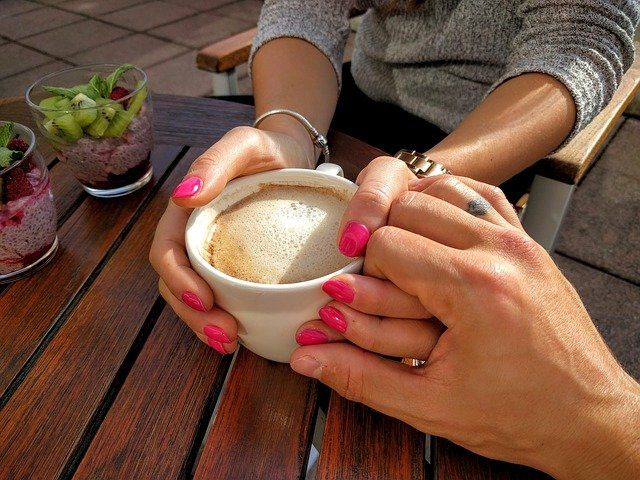The world is united by many things and varied types of coffee are of the better lot! From Lattes to Mochas, Espressos to Americano, Cappuccinos to the viral Dalgona, the flavors keep multiplying. However, beyond the flavors, what actually makes one stand out from the other is their complex compositions and builds. Some of the most consumed types of coffee drinks globally that are going to be in the series include the Latte, Mocha, Cappuccino, Espresso, Espresso Doppio, Americano, Flat White, Ristretto, Café Macchiato, Café Noisette.
The classy Latte
Originally known as Café Latte, this drink originates in Italy. The Latte is a milk coffee that was found back in the late 19th century. The Italians now, almost always make it at home for breakfasts. Latte Art is one of the most famous edible art practices in the industry at present. A standard international latte is a sub branch of the Espresso infused types of coffee and has similarity with cappuccino.
Ingredients: Steamed milk, Espresso shot, milk foam.
Process: A large cup is first filled by either a single (30 ml) or double (60 ml) shots of Espresso which is then topped by a thick layer of steamed milk (about 250 to 300 ml) that makes for most part of the drink. This is topped by a thin layer of foam.
The chocolaty Mocha
Mocha is another coffee which originates from Italy. The name of Mocha, we however get from the city of Mocha in Yemen, one of the earliest traders of coffee. The Mocaccino is a chocolatier version of the latte. We also know Mocha as Hot Chocolate. We serve Mocha in glasses instead of cups.
Ingredients: Espresso, Steamed milk, chocolate.
Process: The drink consists of a shot of Espresso, single or double, at the bottom. Follow this by a layer of chocolate, about 60 ml. Top it with steamed milk of 30 ml.
The loved Cappuccino
This drink originates from Austria while the later developments took place in Italy. It did not go out of Italy until the 1930s. The Viennese, on the other hand, refer to the name origin as Kapuziner coffee. Mostly prepared with the Espresso maker, cappuccinos are so popular that many organizations hold cappuccino making competitions today! The temperature, composition and velvety texture of milk in the drink make all the difference.
Ingredients: Espresso, Steamed milk, Foamed milk.
Process: You create a micro foam from the milk when steamed. Then use this with a single shot of 60ml Espresso. Top it up with foam and voila!

The mighty Espresso
Espresso is both a coffee brewing type and a coffee drink, the most famous one globally. Espresso forms numerous types of coffee. Multiple other drinks branch out from this main type. It again finds itself in Italian Origin. It is a strong drink and has a viscosity of warmed up honey because of the thicker concentration. Coffee aficionados often credit Angelo Moriondo with the creation or patent of the espresso or its maker. We pressurize nearly boiling water at about 9 to 10 bars through highly compacted or concentrated ground coffee.
Ingredients: nearly boiling water, ground coffee beans.
Process: You use the Espresso maker where you push water of about 90 °C or 190 °F through ground coffee beans. We make it fit compactly into the maker that results in a thick, black drink, of about 30 ml.

The Espresso Doppio
This is a sub-branch of the original Espresso. A doppio extracts double the shots of Espresso, i.e. about 60 ml (2.1 imp fl oz; 2.0 US fl oz); from having collected double the amount of ground coffee beans in a large basket portafilter. We call a single espresso a “solo” now. This is because earlier it was simply not possible for the machines to extract more than 30 ml at a time. Doppio Espresso is the general shot in most cafes today.

The humble Americano
The Americano entered the English language form the Italian world back in Latin America in the 1970s. Americano is a more diluted version of the Espresso. Someone orders this drink, by a brew sized coffee from an Espresso bar. Americano is very much like a brewed coffee. The strength depends on the shots of Espresso added. The flavor however is different.
Ingredients: Espresso shots- single or double (30 to 60ml), hot water (about 90ml)
Process: You simply add hot water to the shots of Espresso and mixed well.

The soft Flat White
Made with the combination of Espresso and micro foam, a flat white is a warm milk coffee. It is beautified with latte art often. We often compare Flat White to the latte but it is different because it has a smaller volume with lesser micro foam. This indicates a higher concentration of coffee than there is in lattes. Countries like New Zealand and Austria claim for the origins.
Ingredients: Espresso (single or double shot), steamed milk (about 120 ml)
Process: the process of making a flat white is almost identical to that of a cappuccino or latte.

The strong Ristretto
This is a closer variation of the Espresso coffee. Ristretto is a close cut “short shot” of the Espresso. The amount of ground coffee used remains the same. What changed is the finesse of the grounds. Ristretto uses finer grinds with half the amount of water. The shot has its first and second half which helps it stand out from the Espresso. It has a higher concentration with the first part of the shot being more chocolaty or umber in color and the tail of it being more ginger. It has greater relative proportions of much faster extracting compounds.
Ingredients: finer ground coffee, water.
Process: You may make Ristrettos by hand pressed or machine pressed makers. The portafilter has to be filled and tamped with finely ground coffee. Instead of pulling a normal espresso shot, measure at about 15 to 20 ml. Pull out two shots of Ristretto. Nowadays we also consume Ristrettos with hot milk, about 30 ml for two shots.

The Cafe Macchiato
Macchiato is yet another one of your espresso drink with a small amount of milk, usually foamed. Coming from the…… yes you guessed it- Italian origin like many other types of coffee. The word “macchiato” means spotted or stained. This drink is different from the Espresso by a drop of milk. No seriously, Macchiato stemmed from the Baristas explaining their workers the difference between espressos and espressos with a drop of milk! The milk exists to not overwhelm, but balance the strength of the drink.
Ingredients: Espresso (30 or 60 ml), foamed milk (5 to 10 g, heated at about 60–66 °C, for one Espresso shot)
Process: Hot steamed or foamed milk directly poured over the shot of Espresso.
The Cafe Noisette
Noisette is the French word for Hazelnut. We call it noisette because of the exactly hazelnut color it emits after being ready. Noisette is the French equivalent for the Café Macchiato, as it has a tad bit of milk on espresso too. However the milk here is usually hot milk and not foamed or steamed. We often use cream too instead of milk. Therefore, it is strong and heavy but does not give quite the heady espresso experience.
Ingredients: Espresso shots (30/60 ml), Hot milk (about 30 ml)
Process: You serve Noisette on the cup you make. You pour hot milk on the espresso in your drink.

